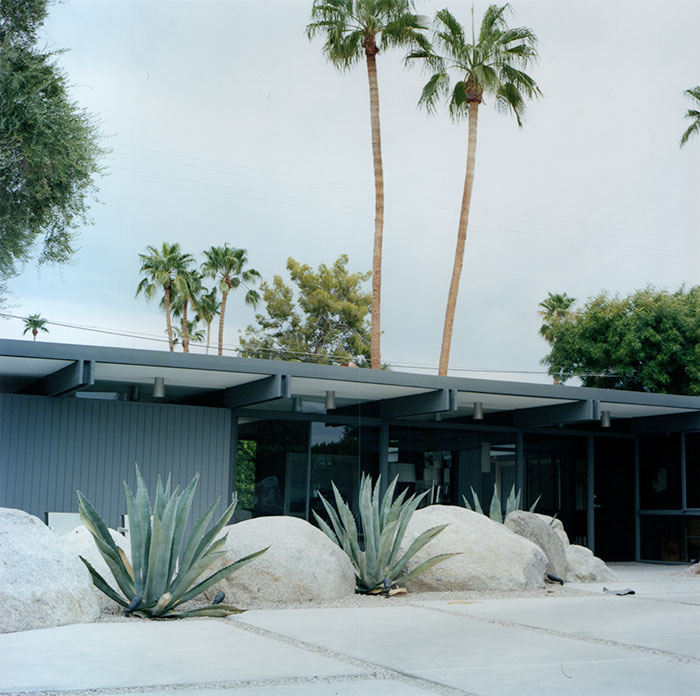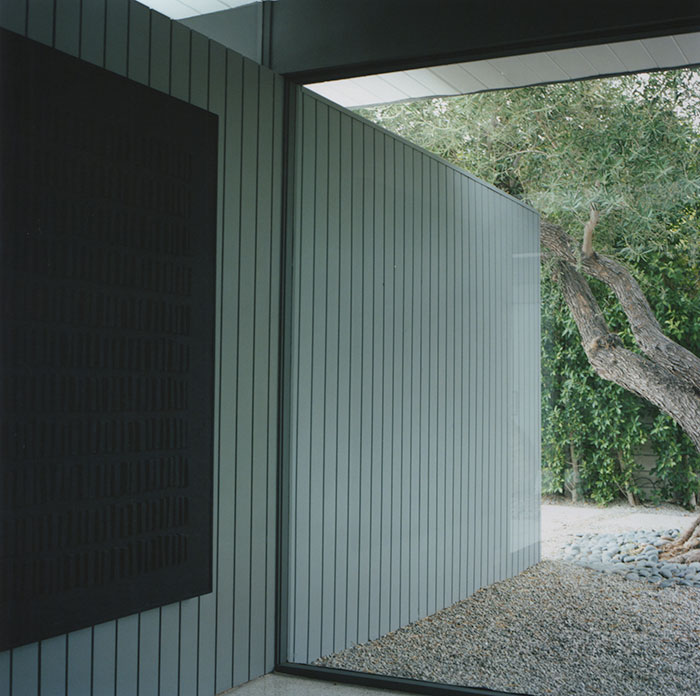Alan Hess. Palm Springs Modern Architecture
|
Donald Wexler, Wexler house (1954), Palm Springs The history of Modern architecture looks different from the corner of Tahquitz Canyon Way and Palm Canyon Drive in the center of downtown Palm Springs. It’s a small town, and it was even smaller in the 1950s when Modern architecture took firm root in the area. The desert landscape offered generous inspiration for Modern architects trained everywhere from the University of Minnesota to the Paris atelier of Le Corbusier. But in Palm Springs (and California in general) the niceties of Modern academic theories were overpowered by the summertime’s scorching heat and the desert’s Eden-like scenery in wintertime. There was also the liberation architects felt in being thousands of miles from the centers of academic Modernism. Together these conditions coaxed ingenious solutions to design and structure that elevated human pleasure above intellectual manifesto. Though historians largely overlooked it until a dozen years ago, Palm Springs nurtured a Modern architecture community since the 1920s. Known for its soothing natural hot springs since the Native American Cahuilla tribe settled there centuries ago, the small resort town had consisted of Spanish, Victorian and vernacular wood ranch buildings until 1924, when local landowner Pearl McCallum McManus hired Lloyd Wright to design a new, Modern hotel. Though his more famous father, Frank Lloyd Wright, would later make the Arizona desert his home at Taliesin West, eldest son Lloyd applied Organic design and modern slip-form concrete construction to this new Oasis hotel. The thick walls keep in warmth in winter (when a fireplace can take the chill off the desert night) and cooled the interior in summer. Donald Wexler, Wexler house (1954), Palm Springs
Steel proved a practical material in the desert. Corrosion was negligible in the rainless desert, and the harsh, inescapable sunlight that warped and corrupted wood had no affect on steel. Wexler’s designs for prefabricated mass-produced houses proved to be his most ingenious use of steel — and much more practical than Buckminster Fuller’s more famous prefabricated steel Dymaxion house. In Wexler’s system, the kitchen and bathroom service core was manufactured offsite in a factory, shipped to the site, and then assembled on a concrete slab with the steel columns, joists and wall panels. The result was a speedily built and solid house which would have been the start of a large scale mass produced steel house industry if the supplier, U.S. Steel, had not raised material prices. The seven examples built testify not only to their ingenious industrial engineering, but to Wexler’s artistry. The houses are elegantly detailed and proportioned with spaces that flow from indoors to outdoors. E. Stewart Williams had joined his architect-father in Palm Springs before World War II, and then returned after to join his practice. His first house was for a notable celebrity, Frank Sinatra, who wandered by chance into his office in 1947. In contrast with Frey’s lightweight structures and Cody’s minimalist simplicity, Williams brought a love of wood and stone to his Modern designs. His own house is a glass house to compete with Mies’ Farnsworth or Philip Johnson’s Glass House. Where those steel-cage houses set themselves apart from their natural setting, Williams allows the garden to flow unhindered throughout the glass-enclosed living areas under a broad butterfly-winged roof. By car, Palm Springs is a two hour drive from Los Angeles. That proximity attracted major Southern California architects who added to the town’s strong community of local architects. Because of his international fame, Richard Neutra’s Kaufmann house was for decades one of the only Palm Springs buildings famous outside the Coachella Valley — thanks in part to photographer Julius Shulman’s photograph of it at twilight against the mountain background. That photograph, the house, and the architect summed up not only Palm Springs, but much of Modernism: a cleanly machined house of right angle steel and glass creating human habitation against the desert wilderness. Edgar Kaufmann is one of the most notable patrons in Modern architecture; besides this internationally famous winter home by Neutra, he had commissioned the even more famous Fallingwater by Frank Lloyd Wright a decade earlier. John Lautner was another other major Los Angeles architect who created great architecture for the Palm Springs desert. As an Organic architect (he was one of Frank Lloyd Wright’s most successful apprentices) he worked in a more natural material, concrete. He displayed the plastic possibilities of concrete in the 1968 Elrod house perched on a ridge high above the desert floor. Lautner ordered his contractor to dig down into the site to reveal massive granite boulders, and then designed the living space around them. Overhead he cast a solid concrete umbrella, sliced radially to create skylights. The roof is solid concrete, but it has the lightness and shape of a flower’s petals. Further up the same ridge, Lautner’s design for entertainer Bob Hope’s house echoes the geologic forms of the mountain itself. Palm Springs is known for such remarkable custom-designed residences, but today it is also known for the mass-produced homes built in Palm Springs by the Los Angeles architects Palmer and Krisel. Known as the Alexander Houses (for the builders, George and Robert Alexander), these houses brought the rationalization of mass production to every detail of the design. Architect William Krisel designed one functional floor plan, which he then rotated on each site to create a different elevation, eliminating the monotonous cookie-cutter appearance of most mass-produced houses of the era. To speed and simplify construction, the doors, windows, kitchens and bathrooms were modular designs. A variety of roof shapes (flat, gabled, butterfly) created unexpected clerestories and dramatic light and views in each house. Palmer and Krisel leveraged the advantages of mechanization against the delights of customized design. Since the rediscovery of Palm Springs Modern architecture a decade ago, the Alexander Houses have become prized subjects for restoration. Palm Springs Modern architecture is much more than an outpost of Europe’s International Style Modernism. Certainly European architecture had some input; Austrian Richard Neutra (who arrived in California in 1924) brought his fascination with sharp-edged machine Modernism to his three houses there. But Neutra had also been a student of the American Frank Lloyd Wright. There can be little doubt that Wright’s expansive openness to the natural setting — especially one as visually dramatic and suggestive as Palm Springs — helped to shape the Kaufmann’s Palm Springs winter home just as much as Neutra’s education in Vienna under Adolf Loos. This pattern was repeated again and again: an architect moved to California from Minnesota, Ohio, Switzerland, Michigan, Austria, or China, but then California reshaped the architect. Its freedom to experiment, the inspiration of climate and landscape, the culture oriented to the future created a distinctive interpretation of Modern architecture.
|

